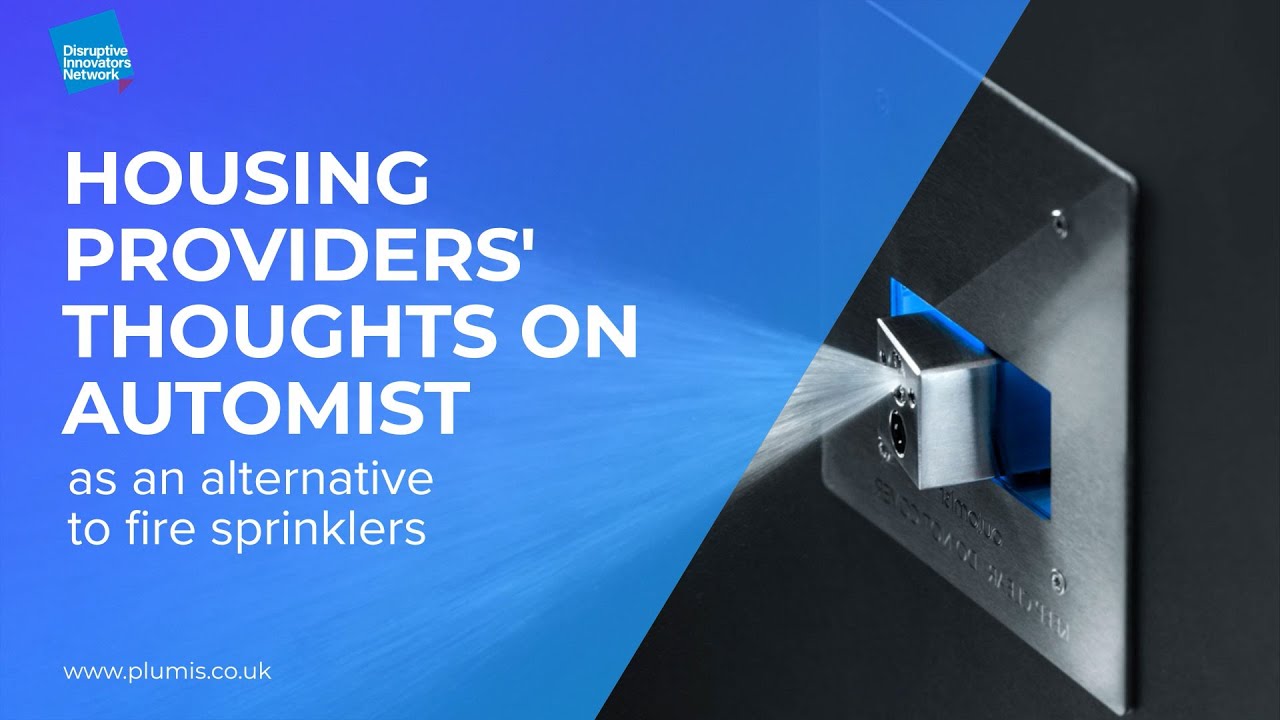How does lifetime cost make the case for Automist over fire sprinklers?
How much will it cost? It is the critical question for any procurement manager working in housing. The housing sector is under significant pressure to do more with fewer resources and position itself as strategically as possible to cope with the challenges of a growing and ageing population.
Therefore when a sheltered accommodation landlord, for example, needs to invest in active fire suppression to address a PEEPs issue, it is hardly surprising that cost tends to top the list of factors considered when purchasing.
Headline prices might vary by thousands of pounds, and the apparent procurement move is to go to the lowest end of the scale.
However, the trouble is that cost can be measured in multiple ways. Relying on the headline price alone can quickly prove to be a costly mistake.
Unconsidered additions
First, additional costs may be layered on top of the headline price that has not been considered.
Think about an online shopper making their way through a website’s checkout, only to be presented with an unexpectedly-high shipping cost or an expensive replacement cartridge cost for a printer.
In the case of active fire suppression, such additional costs can be diverse – and hefty, particularly when installation relies on other subcontractors. Here are some examples:
- Water supply to the system: to be supplied and installed by other contractors
- Cost to supply a priority demand valve if the water main flow is inadequate
- Water supply upgrade if the mains pressure drops over time
- Aligning the sprinkler nozzles with lighting fixtures or HVAC
- Abortive visits or callouts
- Making good of finishes/decoration
- Taking down ceilings
- Bringing out hoses
- Water authority permission when a direct connection
- Electrical supply to the system
- Alarm connection to the system
- Provision of safety lighting during installation
- Drilling a 54mm hole through plasterboard at the dry-line stage
- Suitable shelf/cupboard for unit placement
- Suitable welfare facilities during installation
- Building works
- Core drilling
- Sprinkler nozzle placement at ceiling closure stage
- Asbestos removal in the ceiling
Predicting these costs accurately can be difficult; Landlords can go a long way by asking their supplier to talk them through every stage of deployment, from system design, site preparation, through installation, to ongoing operation and maintenance.
As Automist does not require more water than taken by a standard household appliance, it can be installed in the vast majority of homes without a water infrastructure upgrade. Automist must be connected to a reliable water supply, which delivers 8 litres per minute (lpm) flow at a minimum of 1.5 bar (150kPa) and a maximum of 16 bar (1.6 MPa) static pressure at the point of connection. The pump only requires only 6 lpm and 1 bar pressure, so a safety margin is embedded in this requirement. Mains-fed active fire suppression systems are preferable because if there is a lack of supply, the homeowner will be made aware because there is no water for taps or the toilet, instead of being reliant on a single annual check.
All other systems on the market which take more than 12 litres will require either:
- Permission from the local water company for direct connection to the town main
- Installation of a priority valve, or
- Installation of a large, stored water tank
All in one
While these costs should, of course, be clarified as part of the initial proposal, they can all too easily be hidden away in the small print, or not accurately modelled as part of the organisation’s ongoing growth plan.
Depending on the use of the property, there could be a legal requirement for the system to be serviced on an ongoing basis. If you are a landlord, as an example, you must ensure you do this under The Regulatory Reform Fire Safety Order (England and Wales) or The Fire Safety Regulations (Scotland). Budgeting for ongoing maintenance should be considered.
When a traditional fire sprinkler activates, it can produce 60 litres of water per minute, enough to fill a bathtub in 2 minutes! Not only do fires trigger sprinkler heads, but accidental activation can also occur, especially in areas with high traffic flow or boisterous behaviour. Students have been known to hang washing in sprinkler heads and break the head's vial. People moving furniture may even hit the sprayhead to activate it.
The Association of British Insurers (ABI) is the voice of the UK’s world-leading insurance and long-term savings industry. In their response to the London Assembly Planning Committee Review for Installing Sprinklers in London’s buildings, they said:
2.5 There is a risk that the introduction of more pressurised water systems into dwellings will cause an increase in the number and value of escape of water claims. This is of concern to the insurance industry as escape of water claims are the most consistently expensive peril for domestic property insurers.
Most manufacturers and installers accept no liability for false activation, so make sure you ask the question? We recently spoke to a Director of Property and Development at a UK Housing Association who recently had a sprinkler save after a tea towel left on top of the cooker caught alight as it was left unattended whilst cooking.
“The sprinkler activated and only went off when the fire brigade shut it down. This property is now in the hands of the insurers, with the residents decanted to other properties, hotels etc, for at least 12-18 months. This took their housing team of 4 people the best part of 2 months to sort out. Only 3 of the 12 customers had contents insurance, and the estimated claim on our insurance policy is circa £1m at present. Costs not recoverable by the insurance claim will be covered by other organisational budgets. The unrecoverable costs consumed were circa £10k-£15k in staff time. This also impacted our claims history and premiums by around £20k.”
Automist was designed to minimise the risk of leaks and minimise the consequential water damage of activation. It activates reliably only when triggered by a double knock alarm. Both the detector and the smart scanning head must confirm the presence of a fire. We then target its location with a dense watermist fog. Automist is also a dry pipe non-pressurised system which will provide the coverage you need without the risk of burst pipes. Unlike a wet pipe system, dry systems are free of water until a fire is detected.
Future-proofing homes
Finally, this draws us directly to the importance of considering the expected lifespan of each proposed fire safety technology deployment.
Just as consumers are advised to invest in one or two top-quality, long-lasting investment pieces of clothing; so healthcare organisations are advised to remember that short-term purchases may rapidly become costlier in the long-term.
In 2020, Plumis were awarded an Innovate UK Smart Grant to enhance the functionality of Automist. By combining our advanced engineering technology with IoT, and home safety and security applications, we wanted to add more lifetime value for housing associations by making the system upgradable.
The temperature detecting sensors, which have been independently tested and achieve BS 8458 fire performance, can also detect issues relating to energy efficiency, fuel poverty, cold spots, and potential damp problems, as well as having the potential to monitor the movement and wellbeing of housing association residents.
Thorngate Churcher Trust, for example, has entered a competition to win funding to enable them to utilise Automist to reduce the number of resident falls in its homes to promote healthy living and wellbeing. If successful, the multi-purpose Automist systems will be installed in Thorngate’s new housing scheme in 2024.
They were particularly excited about the prospect of using these sensors to future-proof homes by monitoring people’s presence and movement in a building. This has amazing potential in terms of helping vulnerable people who need additional support to live safely in their homes for longer – increasingly important with an ageing population.
For example, the detector might show that an elderly resident has sat in their armchair all day, they no longer use the bathroom or are cooking in the early hours. This activity or lack of activity might indicate a decline in the person’s physical or mental health.
By flagging up this kind of information to the sheltered housing manager so they can visit and investigate further, we can help them keep residents safer.
In addition, in the event of a fire, data from the sensors could map where individuals are within a property, thereby helping firefighters to work out the best way to help people safely escape from the building.
The potential to safeguard not only residents’ safety but also their health and wellbeing, while enabling better management of their housing, opens up huge scope to future-proof homes and make them more sustainable in the long term.
A day or a lifetime?
All of these different cost models are a reminder that the price of something today is very different from the cost of something over a lifetime.
In active fire suppression, the contrast between the two can be particularly striking because there are so many additional considerations beyond the standalone price of a piece of equipment.
Installation costs, water escape, upgradability, warranty, repairs and maintenance and predicted lifespan are all essential pieces of the overall procurement puzzle.
Review some case studies - Where has Automist been installed?



